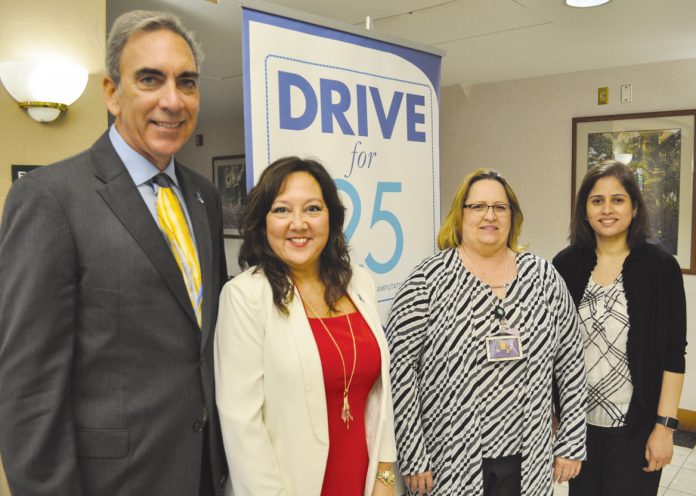
by Bobby Anderson
Staff Writer
Karen Ritchie, RN, has seen the looks come across the faces of new patients walking into the Norman Regional Oklahoma Wound Center.
There’s the understandable fear, anxiety and trepidation that comes with a process that has the possibility of unthinkable outcomes – the loss of limb and possibly life.
As Norman Regional Health System’s diabetic limb salvage nurse navigator, Ritchie always has a smile, caring word and a message for those patients: There’s hope.
That was just one of the messages stressed by Dr. Desmond Bell, DPM, CWS, president and founder of the Save a Leg, Save a Life Foundation (SalSal) during his presentation “The Gift of a Second Chance.”
Bell’s presentation capped a month-long awareness campaign spearheaded by Dr. TaySha Howell and staff at the Oklahoma Wound Center.
“SalSal is about creating awareness in the community and educating patients as well as the medical community,” said NRHS cardiologist Dr. Archana Gautam. “For many years everyone knew about peripheral vascular diseases but nobody was aggressive at treating it.”
Ritchie says that in any given year Oklahoma is No. 1 or No. 2 in the nation in total amputations.
The statistics Bell shared are alarming with more than 65,000 major amputations performed annually for crucial limb ischemia (CLI) alone.
Within five years nearly 70 percent of those patients are dead.
FAILURE IS NOT AN OPTION
“Amputation should not be seen as a treatment option, but a treatment failure,” Bell said, quoting one of his colleagues.
The five-year mortality rate for a non-healing neuropathic ulcer is 45 percent.
Bell singled out the Oklahoma Wound Center as a national leader in promoting wound care awareness.
“Your group here has done a phenomenal job and I just can’t thank you enough,” he said. “You may not realize this but Norman … you all have been the model for what is to come and I’m sure what we’re going to accomplish you’ll look back on this day and be very, very proud in the next few years.”
After Bell addressed the group, patient after patient shared stories about their treatment journey at Oklahoma Wound Center.
“I drive a truck for a living and I was worried about not being able to do what I did,” said Eldon P., who presented with a diabetic toe. “I didn’t want to be in a wheelchair. It’s pretty scary and I went through some pretty rough times emotionally thinking I might lose a limb.”
The therapies, including hyperbaric oxygen dives, helped save his foot.
“It was a long journey, but well worth it,” said Carol T., beginning to tear up while sharing her diabetic ulcer story. “I definitely got the second chance message. There are things you take for granted until you could be missing it. I just thank Dr. Howell and her whole team.”
Bell said the SalSal Foundation is in its infancy, much like the Breast Cancer Awareness group Susan G. Komen Foundation was years ago.
That group started with a promise from one sister to another.
“Imagine what we could do if we had a dollar from every single person with diabetes in this country. It’s mindboggling but it’s achievable,” Bell said. “Five years from now we’ll look back and the things you all have done for our organization will be among the most impactful.”
Bell pointed out that the underlying factors such as diabetes and peripheral artery disease and obesity are more universal than cancer.
“If someone gets the word cancer thrown at them then all the wheels are set in motion and they become their own best advocate,” Bell said. “Yet our patients don’t understand what’s happening. They don’t understand the pain that’s ahead of them. It’s probably one of the most undignified ways to leave this world.”
“We have to do better, simply stated.”
Howell, wholeheartedly agrees and has a message for patients and clinicians.
“It’s so vital because either the patient doesn’t realize how serious it is … but also sometimes to primary care doctors the wound doesn’t look really infected, big or the patient doesn’t complain it hurts,” Howell said. “So a month goes by and another … and they get bone infection or no blood flow and it just blows up into some disaster where if they come when they first have a wound it’s so much easier to turn around.”
That’s why Ritchie loves her job, because she understands she truly saves lives.
“It’s awesome. Wound care is very different than being a staff nurse or floor nurse,” Ritchie said. “With those patients they come in and you make them feel a little bit better and they are discharged and go on their way. With wound care they come in with wounds they know are going to take time to heal and you see them for weeks.”
“Once you know they’ve been successful – that’s the most awesome, most fulfilling feeling.”
“That’s what you went to nursing school for.”











